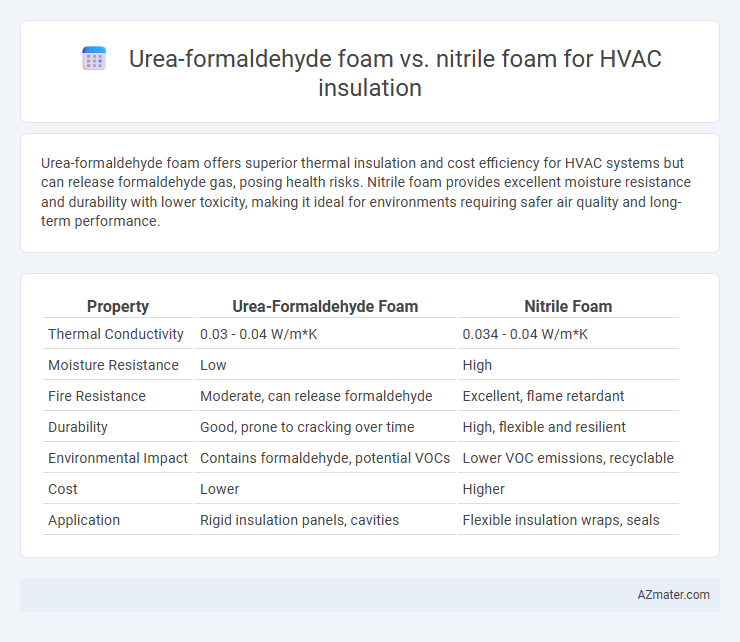Urea-formaldehyde foam offers superior thermal insulation and cost efficiency for HVAC systems but can release formaldehyde gas, posing health risks. Nitrile foam provides excellent moisture resistance and durability with lower toxicity, making it ideal for environments requiring safer air quality and long-term performance.
Table of Comparison
| Property | Urea-Formaldehyde Foam | Nitrile Foam |
|---|---|---|
| Thermal Conductivity | 0.03 - 0.04 W/m*K | 0.034 - 0.04 W/m*K |
| Moisture Resistance | Low | High |
| Fire Resistance | Moderate, can release formaldehyde | Excellent, flame retardant |
| Durability | Good, prone to cracking over time | High, flexible and resilient |
| Environmental Impact | Contains formaldehyde, potential VOCs | Lower VOC emissions, recyclable |
| Cost | Lower | Higher |
| Application | Rigid insulation panels, cavities | Flexible insulation wraps, seals |
Introduction to HVAC Insulation Materials
Urea-formaldehyde foam and nitrile foam are prominent HVAC insulation materials distinguished by their thermal properties and chemical composition. Urea-formaldehyde foam offers excellent thermal resistance with a typical R-value around 5 per inch, making it effective for reducing heat transfer in ductwork. Nitrile foam demonstrates superior flexibility and moisture resistance, enhancing durability and minimizing condensation-related issues in HVAC systems.
Overview of Urea-Formaldehyde Foam
Urea-formaldehyde foam is a rigid, closed-cell insulation material commonly used in HVAC systems for its high thermal resistance and cost-effectiveness. It provides excellent air sealing properties, reducing energy loss and improving system efficiency. Despite concerns about formaldehyde emissions, advancements in formulation have significantly lowered VOC levels, making it a reliable choice for sustainable HVAC insulation.
Overview of Nitrile Foam
Nitrile foam is a synthetic rubber material widely used for HVAC insulation due to its excellent thermal resistance and superior durability compared to urea-formaldehyde foam. It offers enhanced resistance to moisture, chemicals, and UV radiation, making it ideal for environments prone to exposure and long-term wear. Its flexible, closed-cell structure provides efficient thermal and acoustic insulation, leading to energy savings and improved system performance in HVAC applications.
Thermal Insulation Performance Comparison
Urea-formaldehyde foam offers moderate thermal insulation with an R-value typically around 3.5 to 4.0 per inch, making it effective for reducing heat transfer in HVAC systems. Nitrile foam, known for its closed-cell structure, provides superior thermal resistance with R-values ranging from 4.5 to 5.0 per inch, enhancing energy efficiency and preventing condensation. The higher thermal performance of nitrile foam results in better temperature control and reduced energy costs compared to urea-formaldehyde foam in HVAC insulation applications.
Moisture Resistance and Water Absorption
Urea-formaldehyde foam exhibits moderate moisture resistance with a tendency to absorb water over time, potentially compromising its insulating properties in HVAC applications. In contrast, nitrile foam offers superior moisture resistance and significantly lower water absorption rates, enhancing durability and maintaining thermal efficiency in humid or wet environments. Selecting nitrile foam for HVAC insulation ensures prolonged protection against moisture-related deterioration and mold growth.
Fire Resistance and Safety Considerations
Urea-formaldehyde foam insulation provides superior fire resistance due to its inherent flame-retardant properties and ability to char, slowing fire spread in HVAC systems. Nitrile foam, while flexible and resistant to oils, offers lower fire resistance, making it less suitable for applications requiring stringent fire safety standards. Safety considerations favor urea-formaldehyde foam in environments demanding enhanced fire protection, whereas nitrile foam is better for areas prioritizing chemical resistance and flexibility.
Durability and Longevity in HVAC Systems
Urea-formaldehyde foam offers excellent thermal insulation but tends to degrade faster under moisture exposure, reducing overall durability in HVAC systems. Nitrile foam exhibits superior longevity due to its resistance to moisture, chemicals, and temperature fluctuations, making it ideal for long-term HVAC insulation. The enhanced durability of nitrile foam minimizes maintenance costs and ensures consistent thermal performance over time.
Installation and Application Differences
Urea-formaldehyde foam insulation requires professional installation due to its chemical composition and potential health hazards, making it less suitable for DIY projects, whereas nitrile foam is easier to handle and install, often used in flexible HVAC duct linings. Urea-formaldehyde foam offers excellent thermal insulation and air sealing but can off-gas formaldehyde, requiring proper ventilation during application, while nitrile foam provides good thermal and acoustic properties with added resistance to moisture and chemicals, ideal for environments prone to dampness. The rigid structure of urea-formaldehyde foam creates a durable, sealed layer, contrasting with nitrile's flexible nature that conforms to irregular surfaces and facilitates easier system modifications or repairs.
Environmental Impact and Chemical Safety
Urea-formaldehyde foam insulation releases formaldehyde, a volatile organic compound (VOC) linked to respiratory issues and indoor air quality concerns, whereas nitrile foam contains fewer harmful emissions, making it a safer option for indoor environments. Nitrile foam insulation is more environmentally friendly due to its lower toxicity, improved chemical resistance, and better recyclability compared to urea-formaldehyde foam, which can degrade and release formaldehyde over time. Considering environmental impact and chemical safety, nitrile foam insulation is preferred in HVAC applications for reducing pollutant emissions and minimizing health risks.
Cost Analysis and Economic Considerations
Urea-formaldehyde foam insulation typically offers a lower upfront cost compared to nitrile foam, making it a budget-friendly option for HVAC applications. However, nitrile foam provides superior durability and resistance to moisture and chemicals, potentially reducing long-term maintenance and replacement expenses. Economic considerations should weigh initial investment against lifecycle savings, with nitrile foam often delivering better value in environments requiring enhanced performance and longevity.

Infographic: Urea-formaldehyde foam vs Nitrile foam for HVAC insulation
 azmater.com
azmater.com